 |

Tools:








The changing toy landscape in the U.S.
Gurus and experts – there is this talk about how the toy space is changing. You have to give the consumer a new narrative, says one. No, you have to address the fact that mothers now hate the toys they loved as children, says another. Smart phones are taking over the world, says the third. No, the issue is that we have gender-focused retailing and this has to stop, NOW! And so on.
Yes, there is a fundamental shift under way but it is none of the above. It is the way toys are bought.
I interviewed the shopfloor assistants in the stores included in the Klosters Retailer Panel and this is what they observe on a daily basis:
Right now, toys are bought mainly at brick-and-mortar retailers and for most toy categories it is the children who make the decision of what to get. The mothers and fathers just fork over the fold. At least half of these purchases are made on impulse – the family goes to ToysRUs or such like, the parents get pulled to the aisle in which the kind is interested, and then the kid gets what he or she wants.
In fact, six out of ten toy purchases made in the store are made on impulse. Also, the kid chooses the toy finally bought in eight out of ten cases.
Not so surprisingly, the decision process is from basic toy category selection to the pack design choices to final pick-up from the shelf. Aisle caps and endcaps obviously have their role in this and their importance, because of visibility, is about ten times compared to an on-shelf position.
This applies to most toy categories. There are two major exceptions. One is Electronic Learning Products - the Leapfrogs and VTechs of this world – where the mother is the main decision maker. But then Electronic Learning Products, specifically the consoles and the software, are not primarily bought to amuse children; they are bought to help enhance educational skills. The second exception are Board Games which are mainly bought in consultation between parents and children since most are still today played in a family setting.
As a general statement, selling toys at brick-and-mortar stores is pretty straight forward. You pick a popular toy category – say Preschool – and you come up with a toy that is new, different and attractive to your preschool consumer. You put it in a package that stands out on the shelf on the strength of compelling design and you price it competitively because if you don’t, Mom or Dad may still veto the purchase. You try to get preferential placement in the store – an endcap or an aisle cap – and you strengthen the presentation with arresting signage. And you promote the dickens out of it using media that reach the little guys.
As I said above – toys today are mainly bought at brick-and-mortar retailers. This is changing and this is where the challenge comes in. Online buying of toys is growing rapidly. This is how the trend developed between 2012 and middle of this year:
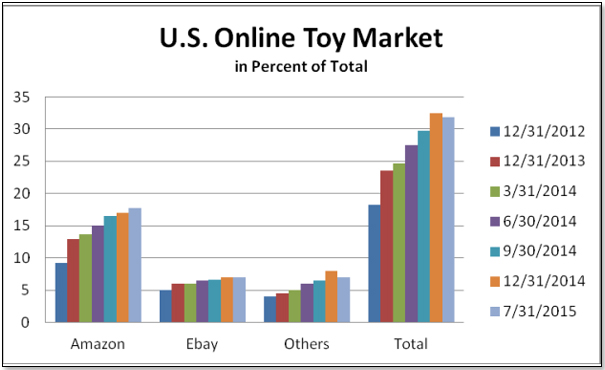
Source: Klosters Retailer Panel
In 2012, online purchases of toys represented about one-sixth of the total. This has now skyrocketed to about 30%.
The success of the online sales platform is mainly attributed to two factors – convenience and price. PwC’s Annual Global Total Retail Consumer Survey [Total Retail 2015: Retailers and the Age of Disruption] made a few interesting observations which presumably apply to toys as well. One addresses the question where purchases are made:
- 67% bought in a store at least once a month
- 54% bought using a PC
- 27% bought using a smart phone
- 24% bought using a tablet.
There is obviously considerable overlap between the four categories but the overall message is clear. Stores are still the preferred point of purchase but the PC is not far behind.
Another question asked was why consumers buy online and this is what PwC’s research showed:
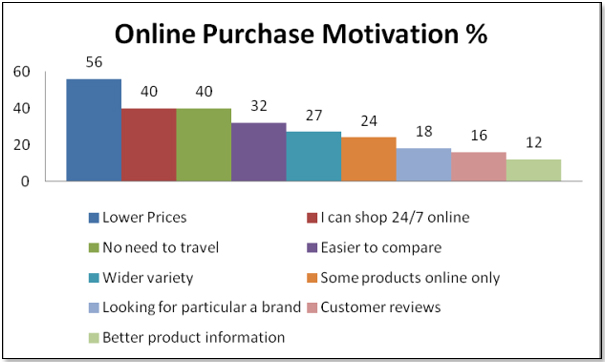
These motivational factors tells us that online purchasing is much more of an adult preference and totally different from what we have seen from our in-store experience.
This suggests two things. One is that the decision process for what toys to buy shifts away from the child to the adult as you move from in-store to online purchasing. The second is that this selection process becomes less dependent on impulse and relies more on targeted purchasing strategy.
This leads to two questions. One is how the retailers are reacting to this change. The other is what the manufacturers are doing about it.
First, the retailers.
All three – Target, ToysRUs and Wal-Mart – have recognized that e-commerce is the wave of the future and they are ramping up to meet this change. They still have ways to go – in the case of Wal-Mart and Target, the online sales percentage is about 3% of the total, and in the case of ToysRus it is 10%. At the same time, they are reducing the brick-and-mortar space devoted to products that have an online percentage higher than the average. Toys, where one-third is bought online, are a prime example.
At least two of the three leading toy retailers are showing signs of cutting toy space. In the case of ToysRUs, the number of traditional TRU stores in the U.S. stood at 305 on 5/3/2014 and 292 at 5/4/15. In the case of their Side-by-Side stores, this went in the same time span from 214 to 213. Considering that the traditional TRU store devotes about 60% of its footprint to toys, and the Side-by-Side store 40%%, this amounts to a 16% reduction in toy space in one year.
The picture at the two other leading retailers also suggests a retrenchment, particularly in the case of Target:
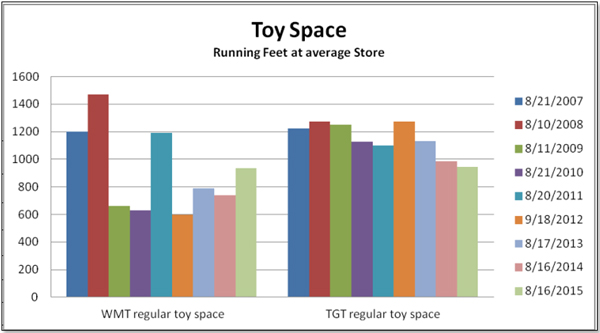
Toy manufacturers are faced with a very complex set of issues in this transition. The most important is that, depending on the product category, between 50% to 70% of shoppers browse in-store and then buy online. The second is that they cater to two different constituencies – the child in the store and the parent at the computer. The third is the selection cascade. In stores you can see what is on the shelf at one glance whereas online you have to go laboriously from one product to the next. Particularly the last, the selection process, calls for a very nuanced approach to product presentation. In the store, where you can handle the pack and look at it from all angles, the overall design of the package is incredibly important. Online, the depiction of the product itself and the product description become more of a deciding factor.
Four of the top six North American toy manufacturers have online stores where consumers can buy their products – the only exceptions are Leapfrog and MGA Entertainment who just refer you to the websites of the leading retailers. However, none of the remaining four – Hasbro, Jakks Pacific, Mattel and Spin Master – attract enough web traffic to their online stores to make the cut on Google Trends. They basically treat their ecommerce business as something of an afterthought and seem to rely on Amazon and the other retailers to do the heavy lifting. And some heavy lifting it is – all four are selling at least some products on their websites at prices considerably lower than what the top retailers charge for exactly the same item. One example each as of August 20, 2015:
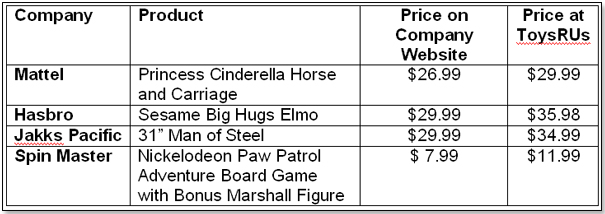
This is in fact very odd since as a manufacturer you really cannot undercut your best customers. I must believe that it is not a conscious decision from the side of these four companies to do so and assume that it is simply due to lack of attention - as I said, treating eCommerce as a somewhat unimportant afterthought.
Unfortunately, the track record of the leading toy retailers is not much better either.
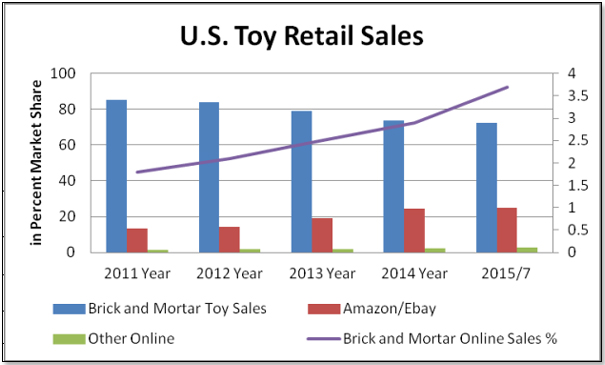
This chart basically shows us that the only people winning the online toy wars are Amazon and EBay who between them today have about a quarter of all toy sales in the United States. Brick-and-Mortar stores have about 70% of all toy retail sales, down from about 85% five years ago. In addition, they and the various toy manufacturers also have less than 5% in online sales.
What this also tells us is that all brick-and-mortar retailers have not so far been able to straddle the chasm between in-store consumer motivation and that governing online buying. Their mindset until today still has been that what applies to the child looking at a shelf in the fashion doll aisle should also apply to the mother surfing the web.
However, this is about to change. In a major effort, Toys“R”Us plans to massively strengthen its U.S. e-commerce operations by bringing them in-house, including building and managing a new platform for all its businesses, by the end of summer 2016. Not to be left behind, Wal-Mart plans to spend between $1.2 billion and $1.5 billion this year on its global e-commerce efforts. And, finally, Target also plans to spend $1 billion this year on beefing up their digital capabilities. I cannot imagine that these very competent and fiscally astute companies would do so without first thinking about the core question of online consumer behavior and motivation.
 Writer's Bio: Writer's Bio: Lutz Muller is a Swiss who has lived on five continents. In the United States, he was the CEO for four manufacturing companies, including two in the toy industry. Since 2002, he has provided competitive intelligence on the toy and video game market to manufacturers and financial institutions coast-to-coast. He gets his information from his retailer panel, from big-box buyers and his many friends in the industry. If anything happens, he is usually the first to know. Read more on his website at www.klosterstrading.com. Read more articles by this author
THIS BANNER IS AN AD:

Back to TDmonthly's front page
|  |
Advertise on TDmonthly

|


